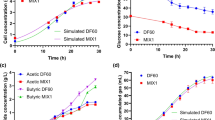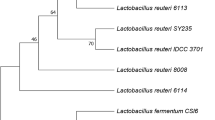Summary
From pasteurized mud and soil samples glycerol-fermenting clostridia that produced 1,3-propanediol, butyrate and acetate were obtained. The isolates were taxonomically characterized and identified as Clostridium butyricum. The most active strain, SH1 = DSM 5431, was able to convert up to 110 g/l of glycerol to 56 g/l of 1,3-propanediol in 29 h. A few Clostridium strains from culture-collections (3 out of 16 of the C. butyricum group) and some isolates of Kutzner from cheese samples were also able to ferment glycerol, but the final concentration and the productivity of 1,3-propanediol was lower than in strain SH1. Strain SH1 grew well in a pH range between 6.0 and 7.5, with a weak optimum at 6.5, and was stimulated by sparging with N2. Best overall productivity was obtained in fed-batch culture with a starting concentration of 5% glycerol. In all fermentations the yield of 1,3-propanediol in relation to glycerol was higher than expected from NADH production by acid formation. On the other hand the H2 production was lower than expected, if per mole of acetyl coenzyme A one mole of H2 is released. The observations point to a substantial transfer of reducing potential from ferredoxin to NAD, which finally results in increased 1,3-propanediol production.
Similar content being viewed by others
References
Biebl H (1991) Glycerol fermentation to 1,3-propanediol by Clostridium butyricum. Measurement of product inhibition by use of a pH-auxostat. Appl Microbiol Biotechnol 35:701–705
Cato EP, George WL, Finegold SM (1986) Genus Clostridium. In: Sneath PHA, Mair NS, Scharpe ME, Holt JG (eds) Bergey's manual of systematic bacteriology, vol 2. Williams and Wilkins, Baltimore, pp 1141–1200
Forage RG, Foster MA (1982) Glycerol fermentation in Klebsiella pneumoniae. Functions of the coenzyme B12-dependent glycerol and diol dehydratases. J Bacteriol 149:413–419
Forsberg CW (1987) Production of 1,3-propanediol from glycerol by Clostridium acetobutylicum and other Clostridium species. Appl Environ Microbiol 53:639–643
Günzel B (1991) Mikrobielle Herstellung von 1,3-Propanediol durch Clostridium butyricum und adsorptive Abtrennung von Diolen. Ph. D. thesis, University of Braunschweig, FRG
Günzel B, Yonsel Ş, Deckwer W-D (1991) Fermentative production of 1,3-propanediol from glycerol by Clostridium butyricum up to a scale of 2 m3. Appl Microbiol Biotechnol 36:289–294
Heyndrickx M, Vos P de, Vancanneyt M, Ley J de (1991) The fermentation of glycerol by Clostridium butyricum LMG 1212 t2 and 1213 t1 and C. pasteurianum LMG 3285. Appl Microbiol Biotechnol 34:637–642
Holdeman LV, Moore WEC (1977) Anaerobe laboratory manual. Virginia Polytechnic Institute, Blackburg, Va.
Homann T, Tag C, Biebl H, Deckwer W-D, Schink B (1990) Fermentation of glycerol to 1,3-propanediol by Klebsiella and Citrobacter strains. Appl Microbiol Biotechnol 33:121–126
Kretschmann J, Caduck F-J, Deckwer W-D, Tag C, Biebl H (1989) Fermentative Herstellung von 1,3-Propanediol. German patent no. DE 3924423 A1
Kutzner HJ (1963) Untersuchungen an Clostridien mit besonderer Berücksichtigung der für die Milchwirtschaft wichtigen Arten. Zentralbl Bakteriol Parasitenk Infektionskr Hyg Abt 1 Orig 191:441–450
Mickelson MN, Werkman CH (1940) Formation of trimethylene glycol from glycerol by Aerobacter. Enzymologia 8:252–256
Nakas JP, Schaedle M, Parkinson CM, Coonley CE, Tanenbaum SW (1983) System development for linked-fermentation production of solvents from algal biomass. Appl Environ Microbiol 46:1017–1023
Petitdemange H, Cherrier C, Raval G Gay R (1976) Regulation of NADH and NADPH-ferredoxin oxidoreductases in clostridia of the butyric group. Biochim Biophys Acta 421:334–347
Pfennig N (1978) Rhodocyclus purpureus gen. nov., sp. nov., a ring-shaped, vitamin B12-requiring member the family Rhodospirillaceae. Int J Syst Bacteriol 28:283–288
Schink B, Zeikus JG (1982) Microbial ecology of pectin decomposition in anoxic lake sediments. J Gen Microbiol 128:393–404
Schink B, Ward JC, Zeikus JG (1981) Microbiology of wet wood: importance of pectin degradation and Clostridium species in living trees. Appl Environ Microbiol 42:526–532
Tag CG (1991) Mikrobielle Herstellung von 1,3-Propanedol. Ph. D. thesis, University of Oldenburg, FRG
Takeda Y, Matsui T (1955) Mycological studies of acetone-butanol fermenting bacteria (KN-18)(Clostridium kainantoi n. sp.). Agric Biol Chem 29:78–82
Author information
Authors and Affiliations
Rights and permissions
About this article
Cite this article
Biebl, H., Marten, S., Hippe, H. et al. Glycerol conversion to 1,3-propanediol by newly isolated clostridia. Appl Microbiol Biotechnol 36, 592–597 (1992). https://doi.org/10.1007/BF00183234
Received:
Accepted:
Issue Date:
DOI: https://doi.org/10.1007/BF00183234




